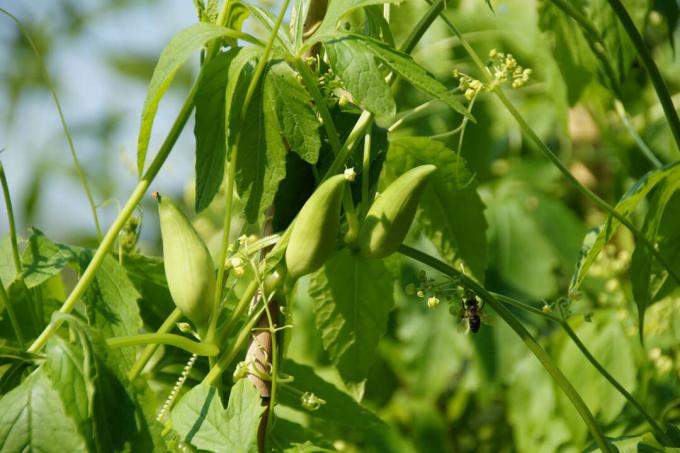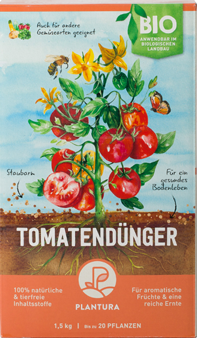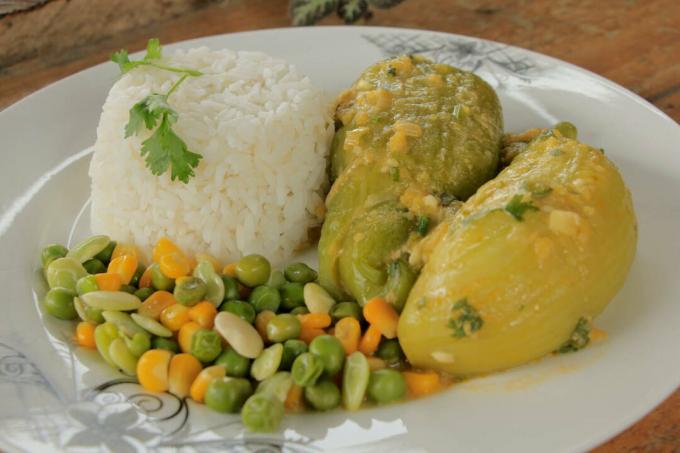The Inca cucumber, also called squirrel pumpkin, can hardly be found in German supermarkets, but also in the gardens. Nevertheless, the cultivation of the Inca cucumber is possible with us.

Mainly the Inca cucumber (Cyclanthera pedata; synonym: Momordica pedata) grown in countries like Peru, Ecuador and Argentina. Since the climbing plant is relatively cold-tolerant, nothing stands in the way of a culture in Germany. In this article you will find out what needs to be considered when sowing and caring for the Inca cucumber and what use there is for the fruit.
contents
- Inca cucumber: origin and properties
- Prefer Inca cucumber and plant
-
The right care
- Fertilize
- Water Inca cucumbers
- Feed Inca cucumbers
- Are Inca cucumbers hardy?
- Harvest: when are Inca cucumbers ripe?
- Effect and use of the Inca cucumber
- Are Inca Cucumbers Poisonous or Edible?
Inca cucumber: origin and properties
In addition to squirrel squash, the plant is known as slice cucumber, olive cucumber or corilla. It is classified in the pumpkin family (Cucurbitaceae). The home of the Inca cucumber is in South America, especially in the Andes. Widespread cultivation takes place in Asia, Central America, Colombia, Venezuela, Bolivia and the countries already mentioned, among others.
The annual climbing plant can reach a height of 4 to 5 m and its five to seven times cut, hand-shaped leaves are somewhat reminiscent of those of a hemp plant (cannabis). The individual lobes are slightly serrated at the edge and taper towards the end. With two or more tendrils, the plant holds on to the climbing aids.
The Inca cucumber has male and female flowers with a double perianth. They are fivefold, greenish-yellow in color and quite small compared to other species of the family. In contrast to the individual female flowers, the male flowers are in 15 to 30 cm long panicles. The egg-shaped, greenish fruits of the pumpkin family are more or less covered with soft spines and are often curved and clearly pointed at the end. They are between 5 and 15 cm long, are often partly hollow and contain several dull dark brown to black seeds.

Prefer Inca cucumber and plant
A sunny and warm place is definitely a suitable location for the Inca cucumber. The soil should be humic, permeable and rich in nutrients and have a good water supply. Planting in a greenhouse is possible. However, this is not absolutely necessary as the plant is quite tolerant of cold and at the altitudes that Cyclanthera pedata can achieve, possibly rather impractical. However, the Inca cucumber can also be cultivated well in a pot. A plant should have a container with a capacity of at least 10 liters available, which is provided with a drain for excess irrigation water. A loose, nutrient-rich vegetable soil, for example, is suitable as a substrate.
Only a few weeks before releasing the plant, you can prefer the Inca cucumber. Here we explain step by step how to do this:
- Time for sowing indoors: mid/late April
- Fill seed soil into pots
- Press the seeds about 2 cm deep into the soil
- Keep substrate constantly moist
- Place the potty in a warm, bright place
- Germination temperature around 20 °C
- germination time approx. 2-4 weeks
- Time for planting out: after the ice saints in mid-May
- Attach a trellis when planting
Can you harvest Inca cucumber seeds yourself? The seeds for next year's culture can also be taken from your own fruits. However, the Inca cucumber fruits should be ripe when harvested, which means they have to remain on the plant much longer than the young fruits harvested for consumption.

The right care
When caring for the Inca cucumber, the nutrient and water supply play a particularly important role. You can find out what to look out for in the following.
Fertilize
Since the Inca cucumber is one of the so-called heavy feeders, it needs some nutrients for healthy growth and a rich fruit set. In order to ensure a sufficient supply of nutrients, it is best to mix compost under the soil when planting. In the further course, the climbing plant can then be supplied with a primarily organic long-term fertilizer. For example, ours is ideal for this Plantura organic tomato fertilizer very well, which has a high proportion of potassium to support fruit formation. Since the fertilizer has a 3-month long-term effect, only two fertilizer applications are necessary throughout the season.

Plantura organic tomato fertilizer
effective long-term effect,
good for the soil, harmless for humans, animals and nature
Water Inca cucumbers
Due to the equally high demand for a constant water supply, regular watering should be used to prevent the soil from drying out. As soon as the top layer of soil has dried out, it should be watered again. However, waterlogging is just as undesirable as dryness.
Feed Inca cucumbers
Furthermore, it should be checked from time to time whether the climbing aid is sufficient. If necessary, shoots have to be guided upwards by hand, as the plant is very fast-growing and forms long runners.
Are Inca cucumbers hardy?
Due to its cold tolerance, the Inca cucumber continues to grow even at low temperatures just above 0 °C. The climbing plant can also withstand minus temperatures of around -5 °C. But she wouldn't survive the winter in our grades.
Harvest: when are Inca cucumbers ripe?
When you can harvest the Inca cucumbers depends entirely on the desired use. The young fruits can be harvested from about July. If the ripe Inca cucumber fruits are needed, you have to be patient until around the end of August. If the Inca cucumbers are harvested when ripe, the hard seeds should definitely be removed before consumption or processing.
Effect and use of the Inca cucumber
In the meantime, several studies have shown that the plant has a positive effect on human health. Each plant part of the Inca cucumber is attributed such a healing effect: Anti-inflammatory ointments are made from the leaves, for example, with the help of a Drinking from the fruit can promote detoxification and blood purification, and the ground seeds can be used to make a tea that helps against high blood pressure target. The squirrel pumpkin is also said to bring relief for digestive problems or high cholesterol levels.

The use of the Inca cucumber in the kitchen is very versatile. The different parts of the plant can be used in different ways. The young shoots and leaves can be used as a soup vegetable, for example, but also in a fresh salad or smoothie. The young fruits are usually eaten raw, but the Inca cucumber can be pickled at this stage. The seeds must be removed from the ripe fruit before preparation. In most Inca cucumber recipes, a wide variety of variants can be found, such as the hollow fruit be filled: Whether with cream cheese, minced meat or rice - there are hardly any limits to your imagination. If the Inca cucumber has spikes, these can be rubbed off when raw - but they will soften anyway when cooked or steamed. Since the fruits are not harmed by low temperatures outdoors, they can also be stored in the refrigerator after harvest. It is important to process the harvested fruits within about 10 days, as they do not have a very long shelf life or shelf life.
What taste does the Inca cucumber have? If the young fruit is eaten raw, the taste of the Inca cucumber is reminiscent of the cucumber (Cucumis). If it is prepared later in another way, for example fried, grilled or steamed, then the taste can be compared to that of a zucchini (Cucurbita pepo subsp. pepo convar. giromontiina) to compare.

Are Inca Cucumbers Poisonous or Edible?
The Inca cucumbers are not poisonous: Harvested when young, they can be eaten raw like cucumbers. Later, the fruit can be prepared like zucchini - but the seeds of the Inca cucumber should be removed, as they become hard. Even the leaves and young vines of the squirrel squash can be eaten raw or cooked.
Another vegetable from the pumpkin family that is not very common here is the bitter melon (Momordica charantia), also called bitter gourd. You can learn more about this plant in our special article.
...and receive concentrated plant knowledge and inspiration directly in your e-mail inbox every Sunday!



